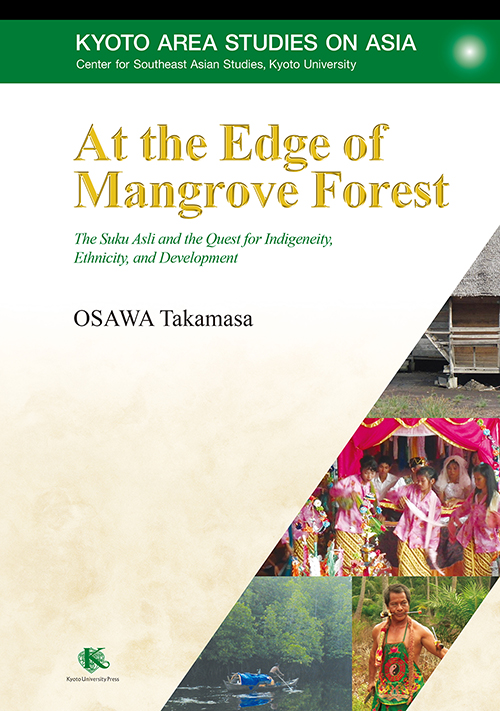Home > Book Detail Page

At the Edge of Mangrove Forest
The Suku Asli and the Quest for Indigeneity, Ethnicity, and Development
225mm x160mmhardcover, 238 pages
ISBN: 9784814004348
pub. date: 06/22
Written Language: English
Publisher: Kyoto University Press & Trans Pacific Press
This book explores the emergence of indigeneity among the Suku Asli, a group of
post-foragers living on the eastern coast of Sumatra, Indonesia. In the past, despite
indefinite ethnic boundaries and the fluidity of their identity, they were known as
Utan (Forest) or Orang Utan (Forest People). Since 2005, however, their
indigeneity has been problematized and many Utan have adopted the new
ethnonym of ‘Suku Asli’ (indigenous people) and begun claiming their position
within the Indonesian state as an integrated and distinctive ethnic group—a group,
that is, associated with a unique adat (tradition), a particular indigenous identity,
and ancestral lands. The emergence of this identity reflects not only their own
aspirations but also their entanglement with a government that aims to transform
the lives of local tribal people.
The development of Suku Asli indigeneity in the context of Indonesia is imagined,
articulated, and recognized in a very particular way by the state. However, the Suku
Asli have a tacit, non-articulated, and unconscious identity and connection with
place that has been fostered in their history—that is, indigeny. It is through the
liaison between indigeneity and indigeny that the Suku Asli have reconfigured their
traditional identity and place within the nation state. Focusing on some of the most
important manifestations and embodiments, this book charts the emergence of
indigeneity and relates it to the entanglement of the people and the government.
Regarding indigeneity as an epistemological perspective, and indigeny as an
indigenous ontology, Takamasa Osawa describes some of the ways in which tribal
people come to embody, resist, and transform the government image of indigenous
people and accomplish their modernization—a modernization demanding, first and
foremost, a distinctive and well-bounded indigenous identity.
post-foragers living on the eastern coast of Sumatra, Indonesia. In the past, despite
indefinite ethnic boundaries and the fluidity of their identity, they were known as
Utan (Forest) or Orang Utan (Forest People). Since 2005, however, their
indigeneity has been problematized and many Utan have adopted the new
ethnonym of ‘Suku Asli’ (indigenous people) and begun claiming their position
within the Indonesian state as an integrated and distinctive ethnic group—a group,
that is, associated with a unique adat (tradition), a particular indigenous identity,
and ancestral lands. The emergence of this identity reflects not only their own
aspirations but also their entanglement with a government that aims to transform
the lives of local tribal people.
The development of Suku Asli indigeneity in the context of Indonesia is imagined,
articulated, and recognized in a very particular way by the state. However, the Suku
Asli have a tacit, non-articulated, and unconscious identity and connection with
place that has been fostered in their history—that is, indigeny. It is through the
liaison between indigeneity and indigeny that the Suku Asli have reconfigured their
traditional identity and place within the nation state. Focusing on some of the most
important manifestations and embodiments, this book charts the emergence of
indigeneity and relates it to the entanglement of the people and the government.
Regarding indigeneity as an epistemological perspective, and indigeny as an
indigenous ontology, Takamasa Osawa describes some of the ways in which tribal
people come to embody, resist, and transform the government image of indigenous
people and accomplish their modernization—a modernization demanding, first and
foremost, a distinctive and well-bounded indigenous identity.
Takamasa Osawa is a social anthropologist who has studied indigenous communities
in Riau, Indonesia. In recent years, he has engaged in a transdisciplinary
project to empower indigenous communities in tropical peatland environments.
in Riau, Indonesia. In recent years, he has engaged in a transdisciplinary
project to empower indigenous communities in tropical peatland environments.
Acknowledgments
Abbreviations
Introduction: Positioning Suku Asli as Indigenous Peoples or an Adat Community
Chapter 1: Under State Politics:
State Formation, Ethnic Category, and Development Subjects
Chapter 2: Identity as Non-Muslims:
Orang Asli, Peranakan, and Ancestral Worship
Chapter 3: Consolidation of People and Place:
Foraging, Space, and Historical Continuity
Chapter 4: Establishment of an Organization:
Leadership, Power, and Government Intervention
Chapter 5: Manifestation of Tradition:
Adat, Performance, and Integration
Chapter 6: Creation of Homogeneity:
Agama, Buddhism, and Abstraction
Conclusion: The Ongoing Quest for Indigeneity
Glossary
Notes
References
Index
Abbreviations
Introduction: Positioning Suku Asli as Indigenous Peoples or an Adat Community
Chapter 1: Under State Politics:
State Formation, Ethnic Category, and Development Subjects
Chapter 2: Identity as Non-Muslims:
Orang Asli, Peranakan, and Ancestral Worship
Chapter 3: Consolidation of People and Place:
Foraging, Space, and Historical Continuity
Chapter 4: Establishment of an Organization:
Leadership, Power, and Government Intervention
Chapter 5: Manifestation of Tradition:
Adat, Performance, and Integration
Chapter 6: Creation of Homogeneity:
Agama, Buddhism, and Abstraction
Conclusion: The Ongoing Quest for Indigeneity
Glossary
Notes
References
Index











